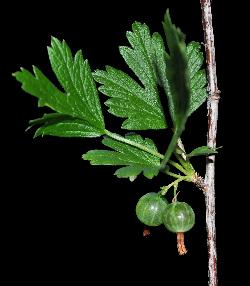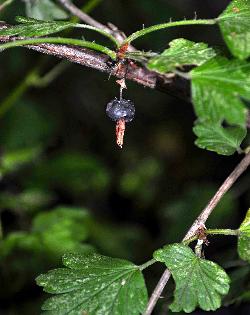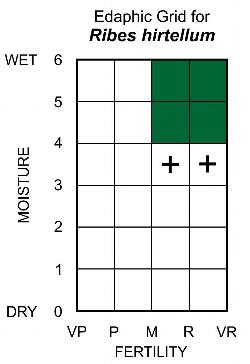Fr: groseillier hérissée, groseillier à trois fleurs, groseillier de marécages, fausse-épine
IA: shapuminakashi, shapumin (the fruit)
Grossulariaceae - Currant Family
Note: Numbers provided in square brackets in the text refer to the image presented above; image numbers are displayed to the lower left of each image.
General: An erect to low-spreading deciduous shrub, 5–9 dm tall; the few stems bear stipular spines at the nodes, but internodes are usually smooth (glabrous) or bear a few prickles [1–4]. Swamp gooseberry fruits are edible and may be made into jams; they are also eaten by a variety of birds and small mammals, while shrubs with upright stems provide nesting sites for songbirds (Weeks and Weeks 2012). Harvard botanist, M.L. Fernald, described a morphologically "extreme" variety of this gooseberry, Ribes hirtellum var. saxosum (Hook.) Fernald, which is apparently very common in Newfoundland. Fernald noted: "To those, however, who are familiar with the flora of Newfoundland and eastern Canada, it is well known that the extreme variation of R. hirtellum with cordate or subcordate leaves on the fruiting branches is a very characteristic plant of certain areas, forming extensive colonies (as at Crabb's Point, Bay of Islands, Newfoundland …), where it's abundance indicates that it is a real phase of R. hirtellum…" (Fernald 1911). Although common in Newfoundland, this variety is no longer considered taxonomically distinct, but the significance of the leaf traits is important to recognize when trying to identify unknown Ribes species.
Swamp gooseberry is resistant to the American gooseberry mildew (Podosphaera mors-uvae (Schwein.) U.Braun & S.Takam.), which was introduced from Europe and infects European gooseberry (Ribes uva-crispa L.) crops. Therefore, swamp gooseberry plants were crossed with the European gooseberry to produce disease resistant cultivars, such as Ribes uva-crispa 'Downing' (Bratsch and Williams 2009). Swamp gooseberries are also susceptible to and serve as an alternate host for white pine blister rust (Cronartium ribicola F.C.Fisch.), a serious disease of white pine (Pinus strobus L.).
Key Features: (numbers 1–3 refer to the illustration [5])
1. Stems bear 1–3 stipular spines at the nodes; middle and upper internodes usually lack prickles; lower internodes may be prickly.
2. Leaves are 3–7 lobed; petioles are finely hairy along the margin and bear scattered long feathery hairs.
3. Berries are green to purplish, glabrous, solitary, or 2–3 in leaf axils.
Stems/twigs: Woody twigs are glabrous, pale greyish-brown, and slightly angled due to decurrent lines that run downward from the edges of the leaf scars [6]. The most notable feature of swamp currant twigs is the usual presence of 1–3 stipular spines (occasionally absent) at each node, smaller prickles may also be present with the stipular spines [7–8]; spines are 3–8 mm long, and wider and longer than internodal prickles. Buds are reddish-brown, sharply pointed (acuminate), and have about 6 imbricate bud scales [9–10]; leaf scars are narrow, V-shaped, and have 3 bundle trace scars. The upper and middle internodes of flowering and fruiting stems usually lack prickles, but several scattered bristle-like prickles may be present, especially along lower internodes [11–12]. Young (green) branches are also likely to be prickly along the internodes (Fernald 1970) [13]. The outer bark layer of maturing stems splits vertically into shreds and peels off, along with any slender prickles, revealing the smooth reddish-brown permanent bark [14]. Occasional plants of swamp gooseberry have been observed with most stems bearing only stipular spines, but also with a few branches that were very prickly along the internodes.
Leaves: Alternate, simple, and palmately-lobed, with 3–7 rounded lobes; petioles are up to 3 cm long, finely and softly hairy along the edges, and have scattered slender feathery hairs along the petiole margins [15–16]. Leaf blades are 2.5–6 cm long, somewhat rounded in general outline, with the lobes divided nearly halfway to the midrib [17–18]. Leaf bases of swamp gooseberry plants in mainland Canada are usually tapering (cuneate), but in Newfoundland plants, they are often flat (truncate) or cordate, although leaves with cuneate bases are not uncommon here too. The lobes of the blade are each oblong to rounded, with blunt (obtuse) apices and bluntly-toothed margins. The upper leaf surface is dark green and glabrous to slightly hairy; the lower surface is paler and slightly hairy, at least along the veins; glandular hairs are absent from both surfaces.
Flowers: Borne in axillary pendant clusters (corymbs) of usually 1–3 flowers (sometimes up to 5 flowers), on glabrous unjointed pedicels, 2–5 mm long [19–21]. Each flower is subtended by a small ovate bract, 1–2 mm long, with ciliate margins. Flowers are 6–9 mm long, with a tubular greenish-yellow or purple-tinged hypanthium, terminating in 5 erect to spreading lanceolate-oblong calyx lobes, 3–4 mm long, which reflex at maturity [22–23]. The 5 small white to purplish petals are 1.7–2.5 mm long, obovate to spatulate, shallowly lobed along the upper margin, and shorter than and attached to the hypanthium between the calyx lobes. The 5 stamens are exserted and about twice the length of the petals, with filaments 3–4.5 mm long; anthers are cream-coloured and 0.2–0.3 mm long. The single pistil has a glabrous inferior ovary and 2 styles, connate for about half of their 3–4.5 mm length and distinctly hairy below the middle. Pollination of Ribes species is generally by bumblebees and solitary bees (entomophily), and although most currants are self-pollinating, cross pollination will improve fruit yield (Bratsch and Williams 2009).
Fruit: A pendant cluster of edible, but somewhat sour, globose berries, each 8–12 mm in diameter (technically, the fruit is a false berry, derived from an inferior ovary). Berries are glabrous, green when young, and somewhat translucent, with veins visible as pale vertical lines just below the surface [24–26]; the berries become reddish-purple to purplish-black at maturity [27]. After fruit set, the shrivelled tubular brown perianth is persistent at the end of the developing fruit. Dispersal is by animals, who eat the fruit (endozoochory).
Ecology and Habitat: Within the forest, swamp gooseberry usually occurs in wet, nutrient-rich sites, but can also occur in limestone gravels and rocky sites with basic substrates.
Edaphic Grid: See image [28]: the Edaphic Grid for Ribes hirtellum.
Forest Types: Swamp gooseberry is found sporadically in the following forest types:
Alnetum caricetosum (Carex-Alder Swamp Subassociation)
Carici-Piceetum (Carex-Black Spruce Fen Association)
Succession: Swamp gooseberry is only rarely encountered in forests, it usually occurs with low frequency and abundance in open fens and swamps. It appears to have a wide range of shade tolerance, occurring in open to partially shaded habitats.
Distribution: Ribes hirtellum is a north-central and northeastern temperate species with a range in Canada that extends from insular Newfoundland west to Alberta. Swamp gooseberry is found throughout insular Newfoundland, but its range extends north only to southeastern Labrador. In the United States, it extends from Maine west to the Dakotas and southwest to West Virginia (Morin 2008).
Similar Species: Currants and gooseberries are both classified as species of the same genus (Ribes), but currants have several flowers arranged in long racemes, their flowers are borne on jointed pedicels, and the hypanthium is open and saucer-shaped; gooseberries have 1–3 flowers borne on unjointed pedicels in leaf axils, and their flowers have a short tubular hypanthium. Northern gooseberry or Canada gooseberry (Ribes oxyacanthoides L.) is similar to swamp gooseberry; both species can have internodes armed with many stiff prickles in addition to stout nodal spines. Although reported from one location along the southwest coast of Newfoundland, 2 photos of a plant thought to be R. oxyacanthoides show stems with internodal prickles, but no other traits that could confirm its identity, thus reports of northern gooseberry from Newfoundland are unverified. Northern gooseberry can also be differentiated from swamp gooseberry by its smaller leaves, 1.5–4 cm long, leaf blades with numerous glandular hairs on both surfaces, and flowers with short stamens, 1–3.5 mm long, about equal in length to the perianth.



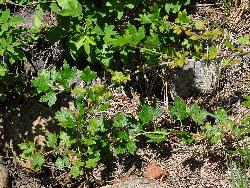
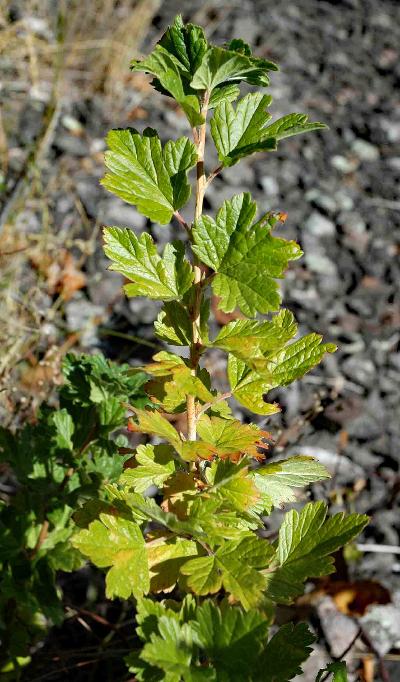
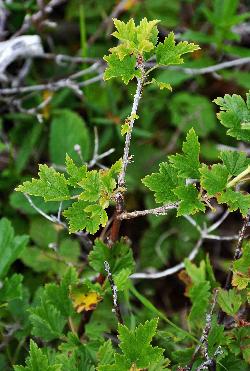

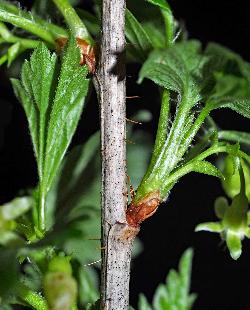
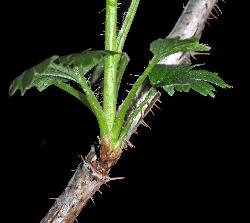



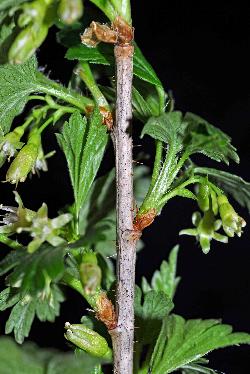
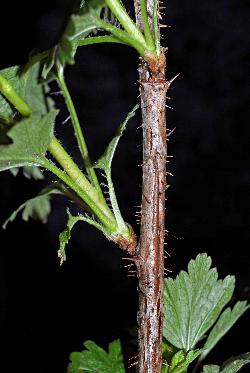
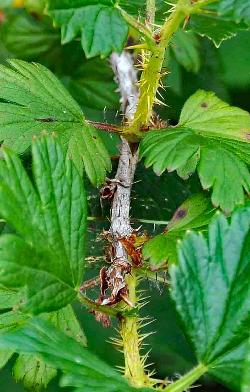
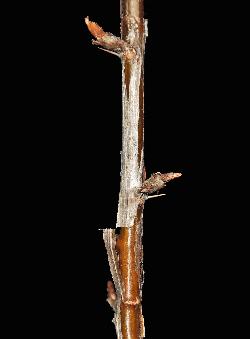

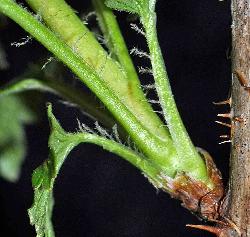
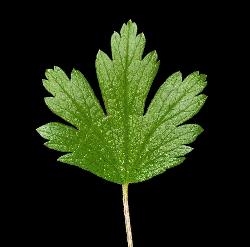
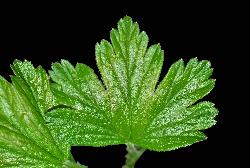

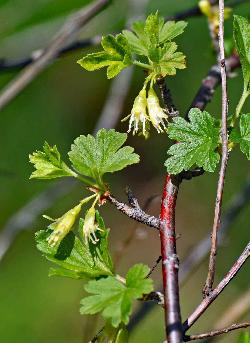
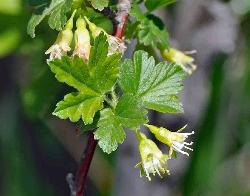

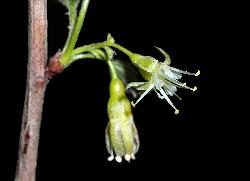
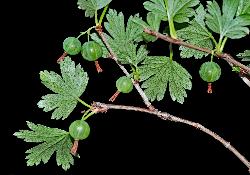
Ribes-hirtellum_sjm1622_July1-12_08_01_2019_1_01_12.jpg)
